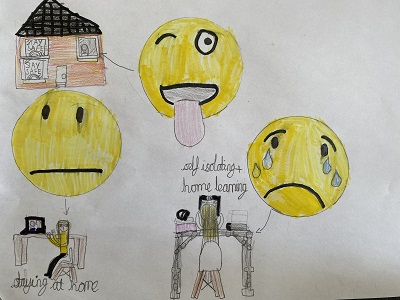Children’s drawings undertaken at the height of Covid-19 revealed a high level of emotions, knowledge and understanding of their experiences.

Submitted drawing showing emotion and feelings - the main theme of the study.
We saw their emotion and we saw their understanding of the virus and of restrictions. Regardless of age and gender, there were common themes - the main one being how did it make them feel and an acute awareness of how it affected the people who they could meet and who they couldn’t.
The study of children’s drawings was open to participants aged 4 – 14 in all parts of the UK and carried out entirely in the home. Children were simply asked to draw a picture about their life since coronavirus struck. Pictures of the drawings were then uploaded to a secure site where parents were asked to complete some demographic and situational questions.
The project has been led by Associate Professor Dr Richard Jolley, with colleagues Dr. Sarah Rose, Dr. Romina Vivaldi and Dr. Claire Barlow, in Staffordshire University Psychology department who then examined the children's drawings using a content analysis method which is often applied to written content.
Analysis carried out on drawings submitted by 68 children during periods and phases of lockdowns between June 2020 and March 2021 showed the outstanding theme to emerge from the project was emotion and how the children thought and felt about the pandemic.
Although there were no significant differences in the content of drawings from different age groups and genders, other major themes included the pandemic’s impact on people, home and natural environments, contamination and transmission, restricted behaviours and personal protection.
Dr Jolley said: “We saw their emotion and we saw their understanding of the virus and of restrictions. Regardless of age and gender, there were common themes - the main one being how did it make them feel and an acute awareness of how it affected the people who they could meet and who they couldn’t.
“There were a lot of drawings – scenes of the house or of nature – used to depict what they could do or what they couldn’t do. Overall, the drawings showed they were very well informed.”
“Unsurprisingly the theme of celebration did not appear as frequently as we would expect in a more open-ended free drawing task. More surprising, there were only a few drawings showing illness, death or loss although this may be because those who suffered heavily during the pandemic didn’t elect to take part in our study. Interestingly the seven drawings that did communicate the death/loss theme were from children who had parents that were key workers.”
Dr Sarah Rose added: “This is an effective way of better understanding how a significant event like the pandemic has impacted children’s lives. Drawings are something children and young people like to do and they can capture a lot about people’s experiences and feelings. Sometimes children are unable to find the words to express how they feel but, as the saying goes, ‘a picture is worth a thousand words’.
The full study, which has been presented at the British Psychological Society (developmental section) conference, will be submitted for publication later this year.